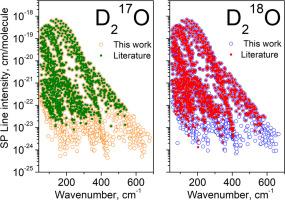从远红外吸收光谱(50-720 cm-1)分析D217O和D218O的经验能级和谱线表
IF 1.9
3区 物理与天体物理
Q2 OPTICS
Journal of Quantitative Spectroscopy & Radiative Transfer
Pub Date : 2025-08-16
DOI:10.1016/j.jqsrt.2025.109638
引用次数: 0
摘要
这一贡献是一个长期项目的一部分,旨在通过分析水蒸汽的九种稳定同位素(H2XO, HDXO, D2XO, X = 16,17和18)的远红外(FIR)光谱,提高我们对它们的能级的认识。在SOLEIL同步加速器上以前所未有的灵敏度记录了傅里叶变换光谱。S. N. Mikhailenko, a . O. Koroleva, a . Campargue J. Phys。化学。参考资料54,023103 (2025)https://doi.org/10.1063/5.0273106),对高富集17O, 18O和氘(D)的5个水蒸气吸收光谱的分析,使HD17O和HD18O次要同位素的观测得到了显著的扩展。结果表明,这些光谱中的D217O和D218O分压(分别高达约0.38 mbar和0.27 mbar)比SOLEIL光谱中D2O物种的分压(S. N. Mikhailenko, E. V. Karlovets, A. O. Koroleva和A. Campargue J. Phys)高出一个数量级。化学。参考数据53,023102 (2024)https://doi.org/10.1063/5.0202355)。结果,D217O和D218O分别新测量了548个和380个跃迁,从而分别确定了147个和59个能级。对于这两个物种中的每一个,测量到的跃迁频率集合被合并到文献来源中,以产生广泛的精确的经验旋转振动能量集,用于地面(000)和第一激发态(010)振动状态。基于这些精确的能级,D217O和D218O的(000)-(000)、(010)-(010)旋转带和ν2带的推荐跃迁列表以10-26 cm/分子的强度截止值生成。对于微波区域(0-1.5 THz),提供了更完整的列表,强度截止降低到10-29 cm/分子。本文章由计算机程序翻译,如有差异,请以英文原文为准。

Empirical energy levels and line lists of D217O, and D218O from the analysis of far infrared absorption spectra (50–720 cm-1)
This contribution is part of a long-term project aiming at improving our knowledge of the energy levels of the nine stable isotopologues of water vapor (H2XO, HDXO, D2XO with X = 16, 17, and 18) from the analysis of their far infrared (FIR) spectra. The Fourier transform spectra were recorded with unprecedented sensitivity at the SOLEIL synchrotron facility. In a recent work (S. N. Mikhailenko, A. O. Koroleva, A. Campargue J. Phys. Chem. Ref. Data 54, 023,103 (2025) https://doi.org/10.1063/5.0273106), the analysis of five absorption spectra of water vapor highly enriched in 17O, 18O and deuterium (D) have allowed a significant extension of the observations for the HD17O and HD18O minor isotopologues. It turns out that the D217O and D218O partial pressures in these spectra (up to about 0.38 mbar and 0.27 mbar, respectively) were about one order of magnitude higher than those in the SOLEIL spectra dedicated to the D2O species (S. N. Mikhailenko, E. V. Karlovets, A. O. Koroleva, and A. Campargue J. Phys. Chem. Ref. Data 53, 023,102 (2024) https://doi.org/10.1063/5.0202355). As a result, 548 and 380 transitions are newly measured for D217O and D218O, respectively, leading to the new determination of 147 and 59 energy levels, respectively. For each of the two species, the set of measured transition frequencies was merged to literature sources to generate extensive sets of accurate empirical rotational-vibrational energies for the ground, (000), and first excited, (010), vibrational states. Based on these accurate energy levels, recommended lists of transitions are generated with a 10–26 cm/molecule intensity cut-off for the (000) – (000), and (010) – (010) rotational bands and the ν2 fundamental band of D217O and D218O. For the microwave region (0 – 1.5 THz), more complete lists with an intensity cut-off lowered to 10–29 cm/molecule are provided.
求助全文
通过发布文献求助,成功后即可免费获取论文全文。
去求助
来源期刊
CiteScore
5.30
自引率
21.70%
发文量
273
审稿时长
58 days
期刊介绍:
Papers with the following subject areas are suitable for publication in the Journal of Quantitative Spectroscopy and Radiative Transfer:
- Theoretical and experimental aspects of the spectra of atoms, molecules, ions, and plasmas.
- Spectral lineshape studies including models and computational algorithms.
- Atmospheric spectroscopy.
- Theoretical and experimental aspects of light scattering.
- Application of light scattering in particle characterization and remote sensing.
- Application of light scattering in biological sciences and medicine.
- Radiative transfer in absorbing, emitting, and scattering media.
- Radiative transfer in stochastic media.

 求助内容:
求助内容: 应助结果提醒方式:
应助结果提醒方式:


